Managing Impulsivity
Introduction
For middle school students, the ability to manage their impulsivity is developmentally aligned. This has been supported by my experience as a middle school educator for the past three years. Each year I see students struggle to manage their impulsivity by calling out, talking during independent work time, jumping into a task before the directions are complete, and speaking before thinking resulting in inappropriate reactions. The impact of this is that students have lost a tremendous about of learning time. Rather than being clear on what is expected, students often miss key components of directions that affect their ability to produce top quality work. By explicitly teaching students about the Habit of Mind of Managing their Impulsivity, my students were able to learn about themselves better. From this newly learned knowledge, they were able to become more self-reflective and implement change. My intentional reinforcement activities allowed students to make managing impulsivity a habit rather than a time-dependent goal.
Explicit Instruction
To introduce students to Managing Impulsivity I created a lesson plan that incorporated a quiz, videos, and brainstorming to facilitate student reflection and application of the new idea of impulsivity. Before the lesson began students were instructed to take a quiz on how impulsive they were. Based o the frequency of select answers, students were able to identify themselves as impulsive, good at managing their impulses, or ready to improve their impulses. This process immediately engaged students and made them curious about what impulsivity exactly was.
After taking the quiz, students watched a clip from Charlie and the Chocolate Factory to illustrate impulsivity. Within this clip, Violet impulsively ate a new chewing gum that was not yet ready for consumption. As a result, she turned into a blueberry. During the clip, students were able to observe the effect of not rationalizing a decision before it is made. After this observation, it was important to me that students were able to see the effect of impulsivity in a real-world context. For this reason, students watched a second clip from Preacher Eric Thomas. During this clip, students observed Dr. Thomas become passionate about race, respect, and education when a group of high schools from St. Louis, MI continued to talk over him. His correlation between urban success and the perception of an inability to manage impulsivity demonstrated to students the importance of the lesson's topic.
After viewing the clips, students worked in groups to identify impulsive behaviors and possible strategies. After highlighting some examples such as calling out, talking, or inappropriate reactions, the class had a discussion about the implications of these behaviors and brainstormed strategies to use for prevention. Many students noted that this negatively affected the learning environment and school culture. Once the discussion was concluded students spent 4 minutes creating an individual action plan to outline their own plan for managing impulsivity. Throughout the remainder of the day, students were using the word "impulsive" to name various behaviors they were observing.
Explicit Instruction Lesson Plan
During my lesson planning process, there were intentional instructional strategies used to engage students. Critical components of this lesson included an interactive quiz, multi-media, graphic organizers, group work, reflection, and goal setting. Students first watched a clip from Charlie and the Chocolate Factory where Violet was forced to leave the tour when an experimental gum turned her into a blueberry. While students found this clip amusing, the observation made the idea of impulsivity "sticky" and a point in which students could start to observe - then build upon- what impulsive behavior is. The second video from Dr. Thomas grounded students in the importance of the habit of managing impulsivities. When Dr. Thomas discusses the stereotypes that are associated with black and brown students, they can see how these behaviors may affect other people's perceptions and their ideas of themselves. Each of these clips prepared students for the opportunity to identify examples of impulsive behaviors and problem solve solutions - a strength of my students. Below is the detailed lesson plan I created prior to execution.
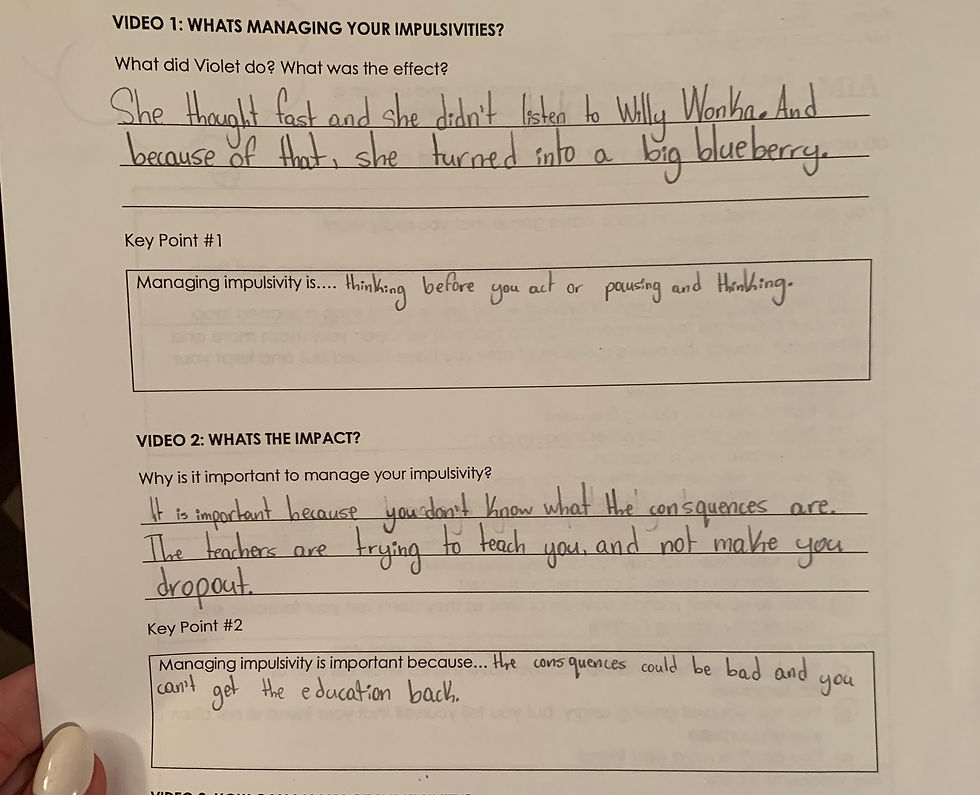
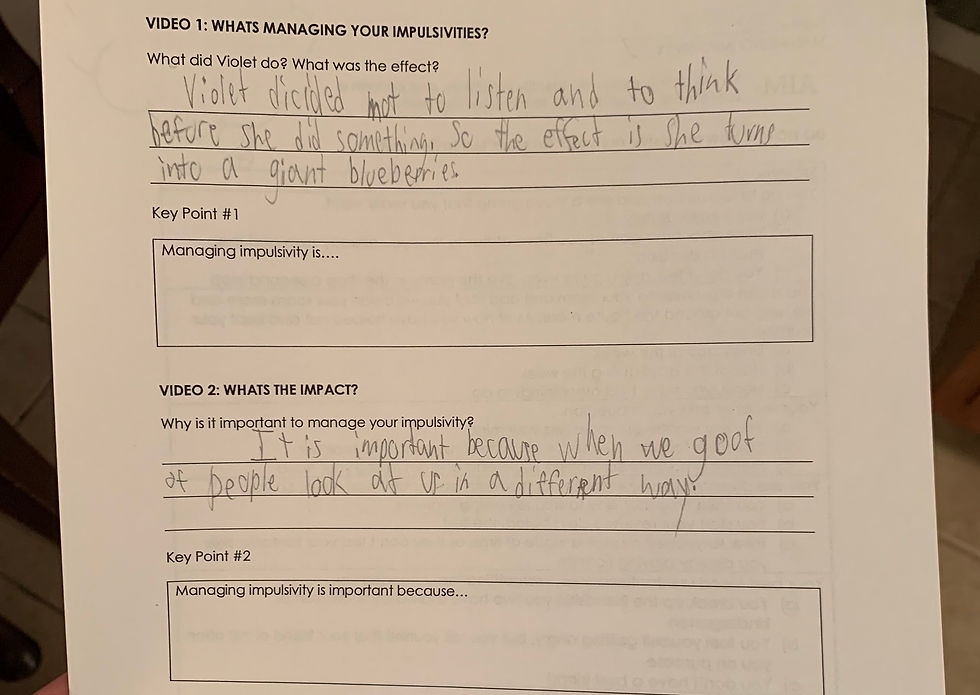


The images to the left are examples of exemplary responses use during our discussion on what managing impulsivity means and why it is important. All students were able to identify the impulsive behavior from the clip from Charlie and the Chocolate Factory. However, each students interpretation of why it is essential to manage your impulsivities varied. The first student named that an inability to manage your impulses could result in a loss of education. A second student named that you could gain a perception of you that is inaccurate. The third student called an inability of managing your impulses as the opportunity to regret a decision.
The images to the right are evidence of students brainstorm sessions to identify impulsive behaviors and possible strategies. Students named calling out, inappropriate reacting, hitting, and eating everything at once as just a few impulsive behaviors. While their examples of impulsive behaviors extended far beyond this, there were common trends about possible strategies including taking deep breath and writing down your feelings.
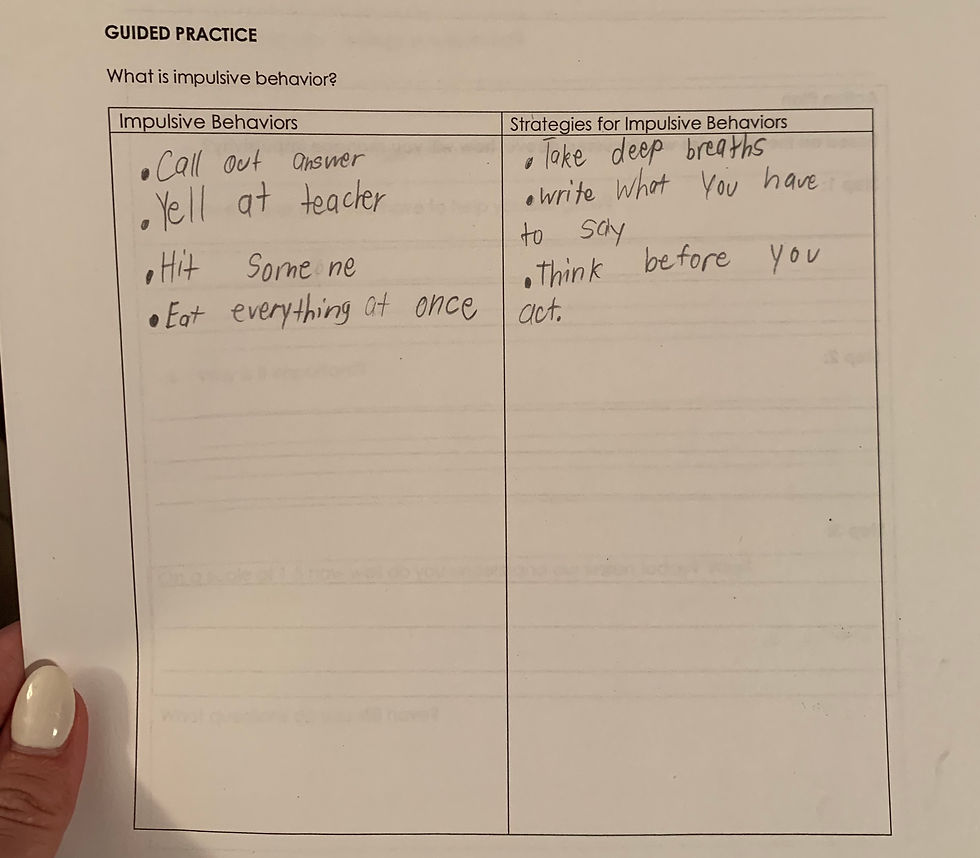
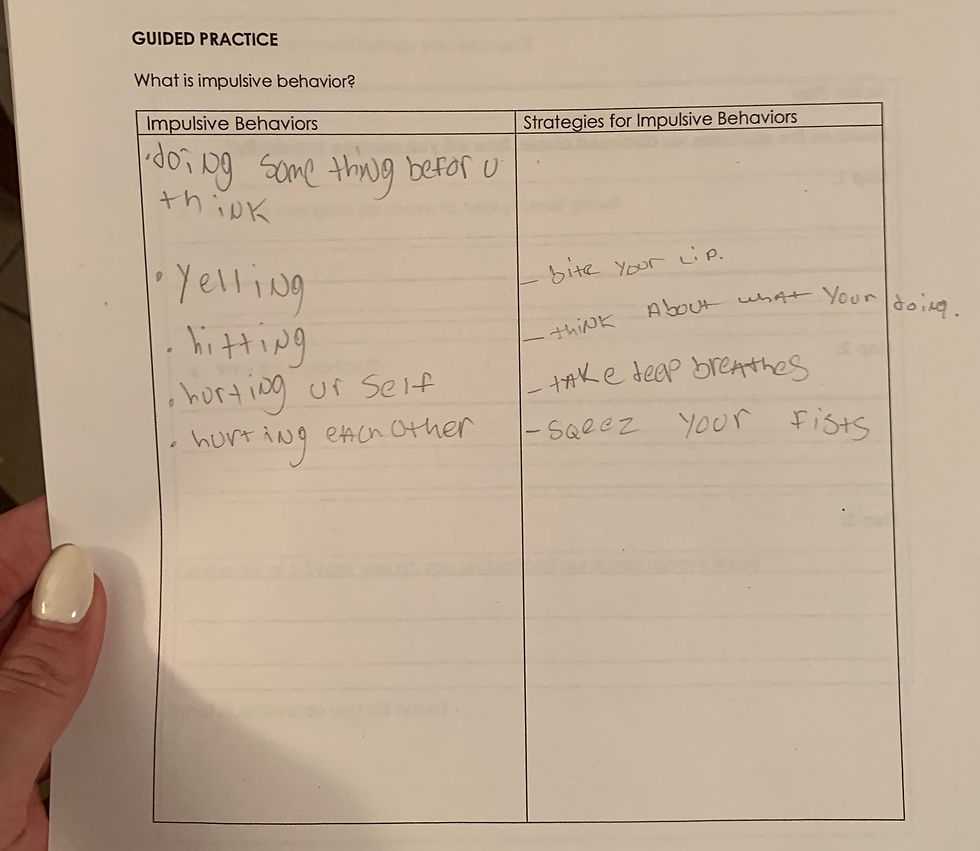
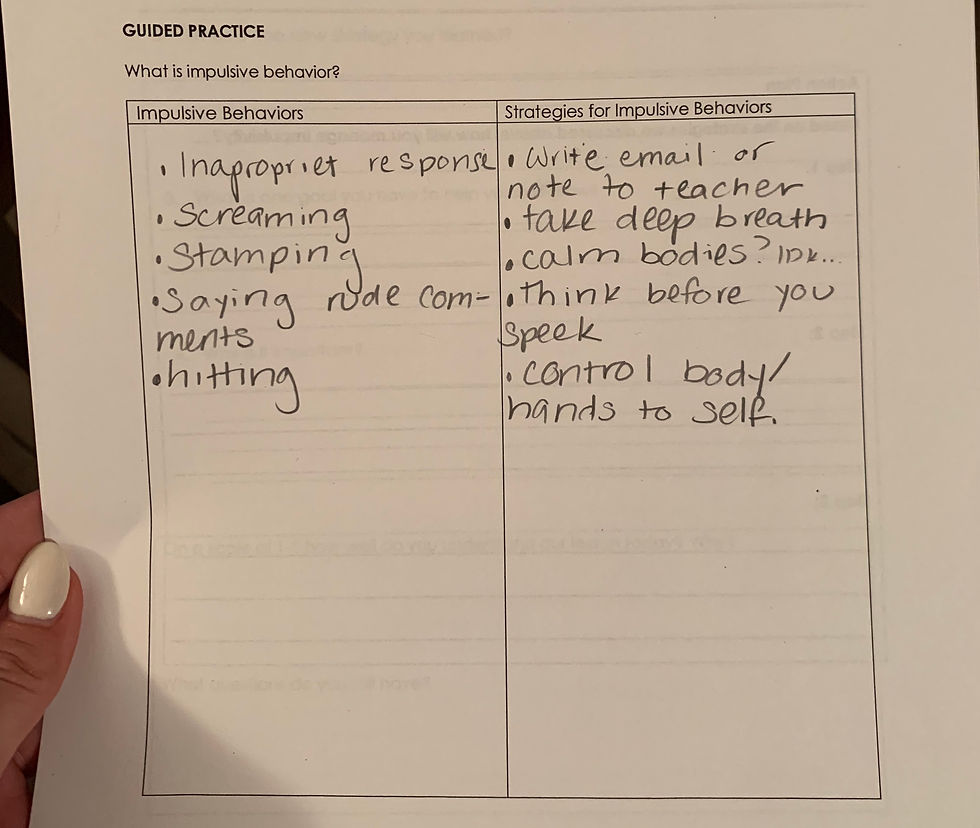

Reinforcement Activities
It is commonly discussed that habits are not created overnight. In order to build a habit, people need to be attentive, reflective, and consistent. Developing habits of adults is comparable to developing habits of children. With this understanding, I planned three different reinforcement activities to help my students build the habit of managing their impulsivities. By consistently returning to this mindset work, students were able to develop a new sense of reflection that could make a significant difference in their social-emotional development.
Saving Munchkins
Below is the reinforcement activity I implemented to further students habit of managing their impulsivity. For this activity, I handed out one munchkin to students at the beginning of our morning check-in. After handing out the munchkins, I explained the activity to students. Students could eat munchkin now or save it and receive a second munchkin at the end of the class. Students were encouraged to select a strategy from our explicit instruction lesson and practice delayed gratification. As our check-in continued, I observed students strategies. Some students choose to put the munchkin behind their backs, others choose to cover it with their tissue paper, a few choose to ignore the munchkin completely, and one student decided to stare at it. It is was not surprising when the student who stared at his munchkin decided to consume it before the class ended. At the end of the activity, students shared their reflections from the experience. Students noted that this activity required them to practice "managing their impulsivity" of wanting to eat the munchkin right away. Later in our conversation, students described why they choose the strategy they did and how effective they thought it was. Students connected this activity to earning or losing scholar dollars during the school day. One student said, "If I think about my paycheck as the reward, like the munchkin was our reward here, then I'll be able to control my impulsivities when I know they'll lose me money." From this point on this activity was used in our daily conversation when students goal-set and reflected on their ability to manage their impulsivities. Images below show students engaging in this activity.
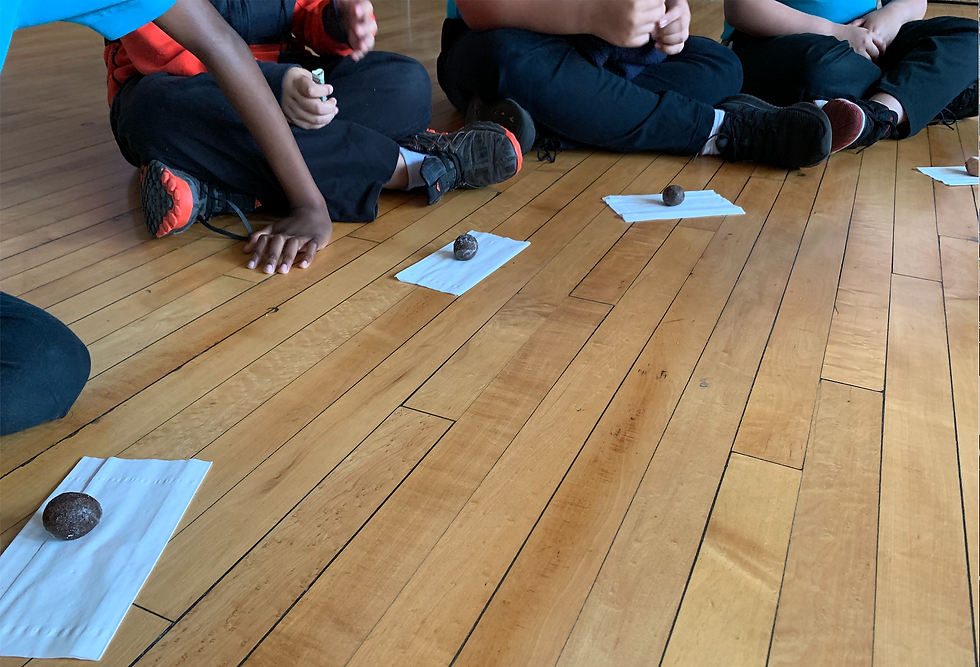


Daily Check-Ins
Below is another reinforcement activity I implemented to further students habit of managing their impulsivity. For this activity, students completed a Google Form to evaluate their daily ability to manage their impulses. These daily check-ins occured for 6 weeks and took place the last 10 minutes of the day. That evening I would look through the data collected and identify trends to discuss during moring meeting. During this time we would discuss events that happened the previous day so students felt their voice was being heard and problem solve for the new day.
The two PDFs below are evidence of students' responses. The student on the left was able to identify his difficulty with managing impulsivity by rating himself a 3 out of 5. While reading through his response further, an account of self-reflection is apparent when he named the strategy that he tried to another and a different one he would try tomorrow. Contrarily, the studnets on the right rated himself a 5 out of 5. This student has exemplarly behavior in managing his impulses and provides insight for other students by naming two different strategies that prove effective for him.
Paycheck Reflection
Below is another reinforcement activity I implemented to further students habit of managing their impulsivity. For this activity, students were able to discuss their paycheck with me and then set a goal. During the week I schedule 10-minute check-ins with each student on my goal team. I met with students once a week for the remainder of the year. At Achievement First, paychecks are part of our behavior management system where students are able to "earn" or "loss" scholar dollars by exhibiting certain behaviors. Seen below is an example of this documentation.

The information provided in a student's paycheck is valuable to be able to evaluate their own progress on building the habit of managing their impulsivities. After our explicit instruction on managing impulsivity, this student made a goal to track her progress by increasing her average. The transcript below is evidence of my conversation with a student to evaluate and goal set on how to increase her paycheck average.
Student: Miss, how can I improve my average?
Teacher: Well, let's take a look at your paycheck.
[Teacher and student look at paycheck together].
Teacher: What do you notice when looking at your paycheck?
Student: I notice that I am losing a lot of money for inappropriate reactions.
Teacher: What is causing you to have inappropriate reactions?
Student: When teachers give me a minor for talking or getting out of my seat I usually talk back because it's annoying.
Teacher: I hear your feeling but it is part of our school policy that a consequence is issued every time a student talks out of turn or gets out of their seat without permission so what let's think about what is in your realm of control.
Student: I guess knowing that this is the school policy and it will happen every time I can pause and think before having an inappropriate reaction.
Teacher: I think pausing is a great idea. How will you do this?
Student: If I feel myself about to talk after a consequence I'm going to catch a bubble and take a deep breath.
Teacher: That's awesome! What impact do you think this strategy will have?
Student: I think I'll be able to save the scholar dollars
Conclusion
The ability to manage your impulsivities is a skill students will use throughout the entirty of their life. Throughout this section, students have been introduced to the Habit of Mind of Managing Impulsivities and engage in a number of activities to improve this habit. Initially students were unfamiliar with this habit. Students had heard of the word self-control but lacked the social-emotional connection that managing impulsivities provides them. Through routine implementations of daily computer-based and weekly personal check-ins my students were able to see great change in their habits. Many students saw a decline in the number of inappropirate reactions they were having and expressed feeling more calm. Both of these results have supported students academic success.